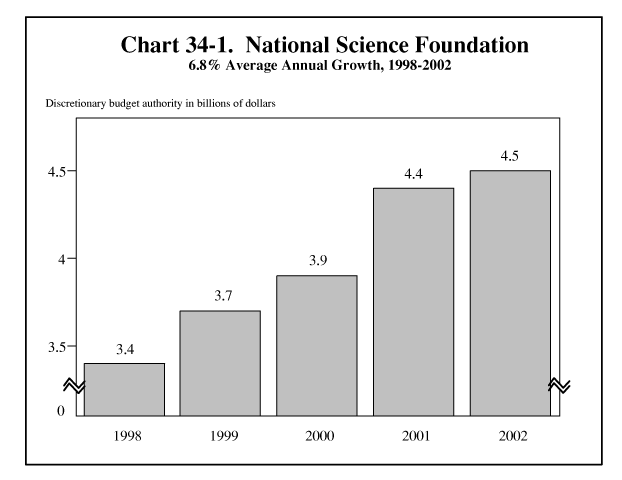
- Afghanistan
- Africa
- Budget Management
- Defense
- Economy
- Education
- Energy
- Environment
- Global Diplomacy
- Health Care
- Homeland Security
- Immigration
- International Trade
- Iraq
- Judicial Nominations
- Middle East
- National Security
- Veterans
|
Home >
News & Policies
|
34. National Science Foundation
|
Initiatives
Math and Science Partnerships: As America enters the 21st Century, many of our neediest students are being left behind. The current state of grade K-12 mathematics and science education in the United States raises significant warning signs. The most recent evidence of deficiencies in U.S. math and science education is from the Third International Math and Science Study, which measured American students in the fourth, eighth, and twelfth grades against comparable students in other countries. Although U.S. fourth graders did relatively well in both math and science, by twelfth grade, the last year of mandatory schooling, U.S. students were among the very worst in the world, and in some areas, such as physics, were last. This evidence indicates that our schools are not preparing our students adequately for today's knowledge-based, technologically rich society or to become future scientists and engineers. Among the underlying causes for the poor performance of U.S. students in the areas of math and science, three problems must be addressed: too many teachers teaching these subjects for which they have not been trained; too few students taking advanced coursework; and too few schools offering challenging curriculum and textbooks

To address these issues, the President is proposing that the National Science Foundation (NSF) initiate a Math and Science Partnership program to provide funds for States to join with institutions of higher education in strengthening K-12 math and science education. The higher education community recognizes that it has a vested interest in working to improve elementary and secondary math and science achievement. More than 20 States have begun to form partnerships with colleges and universities for the purpose of raising math and science standards for students, providing math and science training for teachers, and creating innovative ways to reach underserved schools. For 2002, the President is requesting $200 million for the Math and Science Partnership program and $1 billion over five years. States that access these funds will be required to establish partnership agreements with State colleges, universities, community colleges and school districts, with the goal of strengthening K-12 math and science education. The success of partnerships between States and institutions of higher education will be measured through performance indicators such as improving student performance on State assessments, increasing student participation in advanced courses in math science and their success in passing advanced placement exams, and increasing the numbers of teachers that major in math or science.
Redirected Resources
The 2001 enacted level for NSF included a number of earmarked and lower-priority projects. While the majority of projects must be assessed on their merits through an extensive review process, many of these projects do not face such scrutiny and often address lower-priority areas or needs. The 2002 Budget does not renew funding for these projects, saving $45 million.
The budget also better focuses facility project resources by maintaining commitments for the Large Hadron Collider, the Network for Earthquake Engineering Simulation, and Terascale Computing Systems. Facility project spending will be reduced by $13 million, reflecting no new starts of major facility projects in 2002.
As part of the Math and Science Partnership initiative, $110 million is redirected from existing NSF education programs toward the initiative's $200 million level in 2002.
Potential Reforms
At NSF there are several opportunities for management reforms that will assist the agency in carrying out its mission and planning for the future. The Administration has identified at least three management reform opportunities that will help fulfill the President's promise to make Government more results-oriented.
Reorganize Research in Astronomy and Astrophysics: NSF and NASA provide more than 90 percent of Federal funds for academic astronomy research and facilities. Historically, NASA has funded space-based astronomy and NSF has funded ground-based astronomy, as well as astronomy research proposals. Several changes have evolved which suggest that now is the time to assess the Federal Government's management and organization of astronomical research. NSF and NASA will establish a Blue Ribbon Panel to assess the organizational effectiveness of Federal support of astronomical sciences and, specifically, the pros and cons of transferring NSF's astronomy responsibilities to NASA. The panel may also develop alternative options. This assessment will be completed by September 1, 2001.
Improve the Efficiency of the Research Process: The current size of NSF grants and their duration might be resulting in an inefficient research process at U.S. academic institutions. Researchers might be spending too much time writing grant proposals instead of doing actual research. NSF has increased grant size and duration in previous years, particularly through its priority research areas; however, there is little documentation that this is having a positive impact on research output. With the assistance of U.S. academic research institutions, NSF will develop efficiency measures of the research process and determine what is the right grant size for the myriad types of research the agency funds. These metrics and grant size determinations will be developed in time for consideration of the 2003 Budget.
Increase NSF's Ability to Manage Large Facility Projects: NSF is managing several multi-year, large facility projects. NSF's capability to manage proposed projects needs to be enhanced given the magnitude and costs of these projects. NSF will develop a plan to enhance its capability to estimate costs and provide oversight of project development and construction. This plan should help ensure that NSF is able to meet and stick to cost and schedule commitments for major facility projects.


